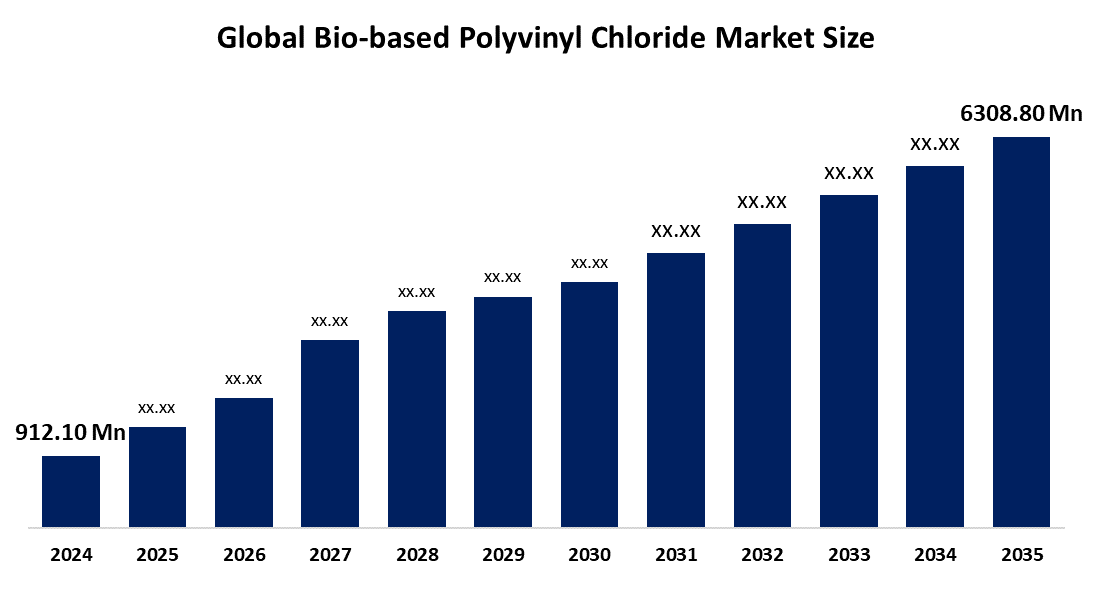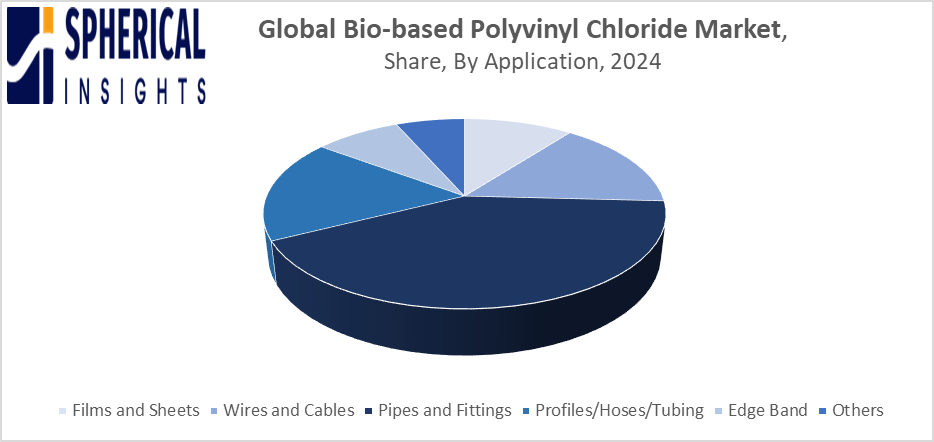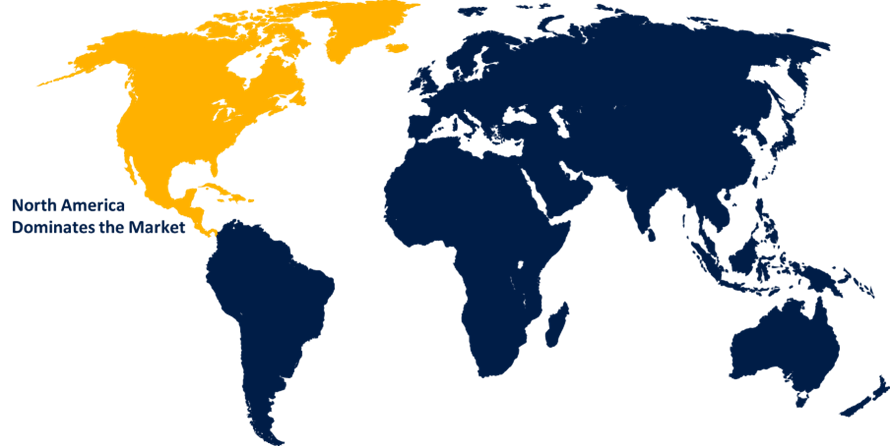Global Bio-based Polyvinyl Chloride Market Size, Share, and COVID-19 Impact Analysis, Russia-Ukraine War Impact, Tariff Analysis, By Product (Rigid and Flexible), By Application (Films and Sheets, Wires and Cables, Pipes and Fittings, Profiles/Hoses/Tubing, Edge Band, and Others), and By Region (North America, Europe, Asia-Pacific, Latin America, Middle East, and Africa), Analysis and Forecast 2025 - 2035
Industry: Chemicals & MaterialsBio-based Polyvinyl Chloride Market Summary, Size & Emerging Trends
According to Spherical Insights, the Global Bio-based Polyvinyl Chloride Market Size is Expected to Grow from USD 912.10 Million in 2024 to USD 6308.80 Million by 2035, at a CAGR of 19.22% during the forecast period 2025-2035. The market for bio-based polyvinyl chloride offers opportunities for environmentally friendly product demand, regulatory compliance, sustainable innovation, and strategic expansion in the green packaging and construction sectors.

Get more details on this report -
Key Market Insights
- Asia Pacific is expected to account for the largest share in the bio-based polyvinyl chloride market during the forecast period.
- In terms of product, the rigid segment is projected to lead the bio-based polyvinyl chloride market in terms of equipment throughout the forecast period
- In terms of application, the pipes and fittings segment captured the largest portion of the market
Global Market Forecast and Revenue Outlook
- 2024 Market Size: USD 912.10 Million
- 2035 Projected Market Size: USD 6308.80 Million
- CAGR (2025-2035): 19.22%
- Asia Pacific: Largest market in 2024
- North America: Fastest growing market
Bio-based Polyvinyl Chloride Market
The global industry devoted to the creation, manufacturing, and marketing of ecologically friendly alternatives to traditional polyvinyl chloride (PVC), which is often sourced from petroleum, is known as the bio-based polyvinyl chloride market. These substitutes are produced from renewable biological resources, including cellulose, starch, plant-based polymers, and other bio-based materials. The market offers solutions that lessen environmental impact, improve recyclability, and comply with regulatory frameworks that aim to restrict the use of toxic and non-renewable materials. Applications include consumer goods, automotive, packaging, medical devices, and construction. The growing need for environmentally friendly and sustainable materials across a range of industries has become a major driver of bio-based polyvinyl chloride (PVC). The rise in demand for bio-based PVC has also been supported by legislative actions and regulations meant to encourage sustainable materials and lower greenhouse gas emissions. The growing need for environmentally friendly and sustainable materials is propelling the market for bio-based polyvinyl chloride (PVC).
Bio-based Polyvinyl Chloride Market Trends
- Increasing R&D Investment: Research and development is receiving more attention in an effort to improve the scalability and performance of bio-based PVC products.
- Adoption in the building and Automotive Sectors: Bio-based PVC is increasingly being used in sectors looking for sustainable material solutions, especially in the building and automotive industries.
- Strategic Partnerships and Collaborations: To speed up commercialization, biopolymer producers, academic institutions, and end-use businesses can work together to expand.
- Regulatory Assistance and Green Certifications: Encouraging the transition to bio-based substitutes by bolstering environmental laws and advancing eco-labeling programs.
Bio-based Polyvinyl Chloride Market Dynamics
Global Bio-based Polyvinyl Chloride Market Report Coverage
| Report Coverage | Details |
|---|---|
| Base Year: | 2024 |
| Market Size in 2024: | USD 912.10 Million |
| Forecast Period: | 2024-2035 |
| Forecast Period CAGR 2024-2035 : | 19.22% |
| 2035 Value Projection: | USD 6308.80 Million |
| Historical Data for: | 2020-2023 |
| No. of Pages: | 250 |
| Tables, Charts & Figures: | 150 |
| Segments covered: | By Product, By Application. |
| Companies covered:: | VinyLoop, Braskem, INOVYN, ENSO Plastics, INEOS Group, Vynova Group, Solvay Indupa, Kaneka Corporation, Dow Mitsui & Co. Ltd., Sylvin Technologies, Inc., BIO-TEC ENVIRONMENTAL, Westlake Vinnolit GmbH & Co. KG, Others, and |
| Pitfalls & Challenges: | COVID-19 Empact,Challenges, Future, Growth, & Analysis |
Get more details on this report -
Driving Factors: The Growing demand for sustainable materials drives the market.
The steadily rising demand for sustainable materials is one of the main factors propelling the bio-based polyvinyl chloride market. Important factors driving the market include customers' growing desire for bio-based products, the requirement for lightweight and durable materials across a range of industries, and increased awareness of the negative environmental effects of traditional PVC. Growing environmental concerns and regulatory demands are the main factors propelling the bio-based polyvinyl chloride (PVC) industry. The need for sustainable alternatives to traditional PVC production, which is highly dependent on fossil fuels and produces high levels of carbon emissions, has increased as a result of growing awareness of its negative consequences.
Restrain Factors: High production costs limit widespread market adoption.
The market for bio-based polyvinyl chloride (PVC) is constrained by a number of problems, such as the high cost of manufacture in comparison to traditional PVC, which prevents widespread adoption. Furthermore, technological issues with bio-based PVC's scalability and consistency of performance prevent it from becoming widely used. Growth is further hampered by the scarcity of raw bio-based feedstocks and supply variations. Additionally, poor infrastructure and a lack of consumer knowledge regarding bio-based substitutes hinder market growth.
Opportunity: Sustainability focus creates growth opportunities for bio-PVC.
The growing emphasis on sustainability and reducing carbon emissions worldwide is driving substantial opportunities for expansion in the bio-based polyvinyl chloride (PVC) industry. Favorable conditions for market expansion are created by growing environmental rules and policies that promote the use of eco-friendly and renewable materials. Product performance and cost efficiency are being improved by technological developments in the production of bio-based polymers, increasing their competitiveness with traditional alternatives. The market opportunity is further supported by rising consumer awareness and demand for green products in industries like packaging, automotive, and construction.
Challenges: High costs and limited resources hinder scalability.
The market for bio-based polyvinyl chloride (PVC) is restricted by a number of issues, including the high cost and restricted supply of renewable raw resources, which have an impact on pricing competitiveness and production scalability. Furthermore, the market is unclear due to the absence of uniform rules and certification procedures for bio-based products. Technical constraints that make it challenging to match the performance of traditional PVC in some applications make adoption across a range of end-use industries even more challenging.
Global Bio-based Polyvinyl Chloride Market Ecosystem Analysis
The ecosystem of the global bio-based polyvinyl chloride (PVC) market includes manufacturers, suppliers of raw materials, technology providers, regulatory agencies, and end-use industries. While manufacturers concentrate on creating high-performance, reasonably priced bio-based PVC, raw material suppliers are essential to guaranteeing the availability of renewable feedstocks. To increase the quality and scalability of products, technological developments and research and development initiatives by important players are crucial. Regulatory agencies use environmental standards and sustainability mandates to affect market dynamics. Demand is driven and the shift to environmentally friendly material alternatives is supported by end-use sectors like packaging, automotive, and construction.
Global Bio-based Polyvinyl Chloride Market, By Product
The rigid segment led the bio-based polyvinyl chloride market, generating the largest revenue share. The rigid PVC is so strong and durable, it is a popular option for a variety of applications, such as pipes, automobile parts, and construction. It is highly valued in these industries due to its resistance to corrosion and capacity to endure extreme environmental conditions, which fuels strong demand.
The flexible segment in the bio-based polyvinyl chloride market is expected to grow at the fastest CAGR over the forecast period. The demand for flexible bio-based PVC products across a range of end-use sectors is also being driven by consumers' growing preference for eco-friendly and sustainable materials.
Global Bio-based Polyvinyl Chloride Market, By Application
The pipes and fittings segment held the largest market share in the bio-based polyvinyl chloride market. Bio-based PVC is perfect for building pipes and fittings because of its minimal maintenance requirements, chemical resistance, and longevity. Additionally, the use of bio-based PVC in pipes and fittings has been fueled by the growing emphasis on sustainability in the water management and construction industries.

Get more details on this report -
The wires and cables segment in the bio-based polyvinyl chloride market is projected to register the fastest CAGR. Growing demand for environmentally friendly insulating materials and expanding infrastructure development in the electrical and electronics industries are the main drivers of the wires and cables segment's growth.
Asia Pacific is expected to account for the largest share of the bio-based polyvinyl chloride market during the forecast period. T
he strong industrial and construction sectors in the Asia Pacific have led to a notable increase in demand for PVC products, in particular bio-based PVC, due to its durability and adaptability. PVC is now widely used in everything from pipes and fittings to consumer items and automobile components due to the fast urbanization and infrastructure development in nations like China and India.
China is experiencing steady growth in the bio-based polyvinyl chloride market is driven by substantial investments in sustainable technologies, heightened industrial demand, and strict environmental restrictions. The use of bio-based PVC in a variety of industries, such as packaging, automotive, and construction, is further supported by China's pledge to lower carbon emissions and promote environmentally friendly materials.
North America is expected to grow at the fastest CAGR in the bio-based polyvinyl chloride market during the forecast period.

Get more details on this report -
The main factors driving North America are stricter regulatory frameworks and growing environmental consciousness, which are meant to lower carbon emissions and encourage the use of sustainable materials. Further driving market expansion is the rising customer preference for eco-friendly products in industries like packaging, automotive, and construction.
The United States is the largest market for bio-based polyvinyl chloride .
The integration of renewable energy sources, the necessity of modernizing the system, and encouraging government regulations are some of the causes propelling the United States. With businesses like Form Energy and ESS Inc., the United States also leads the world in LDES system commercialization and scientific developments.
Competitive Analysis:
The report offers the appropriate analysis of the key organizations/companies involved within the bio-based polyvinyl chloride market, along with a comparative evaluation primarily based on their type of offering, business overviews, geographic presence, enterprise strategies, segment market share, and SWOT analysis. The report also provides an elaborate analysis focusing on the current news and developments of the companies, which includes product development, innovations, joint ventures, partnerships, mergers & acquisitions, strategic alliances, and others. This allows for the evaluation of the overall competition within the market.
WORLDWIDE TOP KEY PLAYERS IN THE BIO-BASED POLYVINYL CHLORIDE MARKET INCLUDE
- VinyLoop
- Braskem
- INOVYN
- ENSO Plastics
- INEOS Group
- Vynova Group
- Solvay Indupa
- Kaneka Corporation
- Dow Mitsui & Co. Ltd.
- Sylvin Technologies, Inc.
- BIO-TEC ENVIRONMENTAL
- Westlake Vinnolit GmbH & Co. KG
- Others
Key Target Audience
- Market Players
- Investors
- End-users
- Government Authorities
- Consulting And Research Firm
- Venture capitalists
- Value-Added Resellers (VARs)
Product Launches in Bio-based Polyvinyl Chloride
- In February 2020, Vynova launched a line of bio-attributed PVC resins that will help clients in every application area develop innovative PVC products while advancing their sustainability objectives. Renewable ethylene, which is made from approved second-generation biomass feedstock and does not interfere with the food chain, is used in the production of the new PVC portfolio.
Market Segment
This study forecasts revenue at global, regional, and country levels from 2020 to 2035. Spherical Insights has segmented the bio-based polyvinyl chloride market based on the below-mentioned segments:
Global Bio-based Polyvinyl Chloride Market, By Product
- Rigid
- Flexible
Global Bio-based Polyvinyl Chloride Market, By Application
- Films and Sheets
- Wires and Cables
- Pipes and Fittings
- Profiles/Hoses/Tubing
- Edge Band
- Others
Global Bio-based Polyvinyl Chloride Market, By Regional Analysis
- North America
- US
- Canada
- Mexico
- Europe
- Germany
- UK
- France
- Italy
- Spain
- Russia
- Rest of Europe
- Asia Pacific
- China
- Japan
- India
- South Korea
- Australia
- Rest of Asia Pacific
- South America
- Brazil
- Argentina
- Rest of South America
- Middle East & Africa
- UAE
- Saudi Arabia
- Qatar
- South Africa
- Rest of the Middle East & Africa
Frequently Asked Questions (FAQ)
-
1. What is the CAGR of the bio-based polyvinyl chloride market over the forecast period?The global bio-based polyvinyl chloride market is projected to expand at a CAGR of 19.22% during the forecast period.
-
2. What is the market size of the bio-based polyvinyl chloride market?The global bio-based polyvinyl chloride market Size is expected to grow from USD 912.10 million in 2024 to USD 6308.80 million by 2035, at a CAGR of 19.22% during the forecast period 2025-2035.
-
3. Which region holds the largest share of the bio-based polyvinyl chloride market?Asia Pacific is anticipated to hold the largest share of the bio-based polyvinyl chloride market over the predicted timeframe.
-
4. Who are the top 10 companies operating in the global bio-based polyvinyl chloride market?Key players include VinyLoop, Braskem, INOVYN, ENSO Plastics, INEOS Group, Vynova Group, Solvay Indupa, Kaneka Corporation, Dow Mitsui & Co. Ltd., Sylvin Technologies, Inc., BIO-TEC ENVIRONMENTAL, Westlake Vinnolit GmbH & Co. KG, and Others.
-
5. What factors are driving the growth of the bio-based polyvinyl chloride market?The growth of the bio-based polyvinyl chloride market is driven by increasing environmental regulations, rising demand for sustainable materials, technological advancements, and growing consumer awareness of eco-friendly alternatives.
-
6. What are the main challenges restricting wider adoption of the bio-based polyvinyl chloride market?The main challenges restricting wider adoption of the bio-based polyvinyl chloride market include high production costs, limited raw material availability, lack of infrastructure, and lower performance compared to conventional PVC alternatives.
-
1. What is the CAGR of the bio-based polyvinyl chloride market over the forecast period?The global bio-based polyvinyl chloride market is projected to expand at a CAGR of 19.22% during the forecast period.
-
2. What is the market size of the bio-based polyvinyl chloride market?The global bio-based polyvinyl chloride market Size is expected to grow from USD 912.10 million in 2024 to USD 6308.80 million by 2035, at a CAGR of 19.22% during the forecast period 2025-2035.
-
3. Which region holds the largest share of the bio-based polyvinyl chloride market?Asia Pacific is anticipated to hold the largest share of the bio-based polyvinyl chloride market over the predicted timeframe.
-
4. Who are the top 10 companies operating in the global bio-based polyvinyl chloride market?Key players include VinyLoop, Braskem, INOVYN, ENSO Plastics, INEOS Group, Vynova Group, Solvay Indupa, Kaneka Corporation, Dow Mitsui & Co. Ltd., Sylvin Technologies, Inc., BIO-TEC ENVIRONMENTAL, Westlake Vinnolit GmbH & Co. KG, and Others.
-
5. What factors are driving the growth of the bio-based polyvinyl chloride market?The growth of the bio-based polyvinyl chloride market is driven by increasing environmental regulations, rising demand for sustainable materials, technological advancements, and growing consumer awareness of eco-friendly alternatives.
-
6. What are the main challenges restricting wider adoption of the bio-based polyvinyl chloride market?The main challenges restricting wider adoption of the bio-based polyvinyl chloride market include high production costs, limited raw material availability, lack of infrastructure, and lower performance compared to conventional PVC alternatives.
Need help to buy this report?